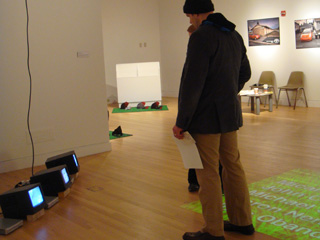Electronic and Time-Based Art
Patti and Rusty Rueff School of Design, Art and Performance, Purdue University
Lorem Ipsum

Gardens and Machines: The Suburban Life
An exhibition of graduate student artworks developed in the course Gardens and Machines – Nature, Art and Technology in the 20th Century and Beyond, taught by Prof. Shannon McMullen in Fall 2008.
February 16 – February 26, 2009
Reception: February 19, 5:00 – 7:00pm
Patti and Rusty Rueff Galleries, Pao Hall
Gallery Hours: Monday – Friday 10am to 5pm
Micah Bowers
John Cessna
Michael Jamison
Aaron Nemec
Juan Obando
In 1964, Leo Marx argued that industrial modernity in the US was defined by the metaphorical opposition between ‘the machine and the garden’—by the opposition between the cultural value of technological innovation and of ‘wild’ nature. A similar argument can be made for other industrialized countries. In the nineteenth century and well into the twentieth, industrial technology was prioritized, producing urban industrial landscapes that dominated and peripheralized the natural environment. Urban space contained only specialized green spaces like parks and gardens. “Nature” (as countryside, wilderness, Landschaft, etc.) existed outside the city limits—physically and conceptually. However, as recent work in landscape architecture and urban design suggests, this relationship is changing. New resolutions of the tension between culture and nature are being explored and realized.
In this grad studio course, we focused on sites where renegotiations between the ‘machine and the garden’ are occurring. This included: brownfields, suburbia, climate change and new developments in science and engineering (nanotechnology, genetic engineering, etc.).
The exhibition Gardens and Machines: The Suburban Life emerged from work done in this course during our critical examination of nature and technology in American suburbs. The projects on view are wide-ranging in their choice of medium and topic:
Micah Bowers’ I Never Saw a Chittimwood, takes its title from a suburban street name in the neighborhood where Bowers grew up. His stop motion video and accompanying original short story raise questions both about the small collisions of nature and technology encountered every day in the suburban environment, and draws attention to the profoundness of everyday interactions that reveal something about human nature.
The photograph series and print brochure that comprise John Cessna’s Perverted Prius use the conventions of advertising to satirize what he sees as the hypocrisy inherent Prius ownership. In Cessna’s words: “A person thinks that they’re morally good because they’ve made a fiscal commitment to the environment, which in reality is 10% “green” and 90% status symbol. In a sense, there’s a mindset that says, “I’m good enough morally and fiscally to care about the earth.” But, the status of the Prius as a contribution to ecological sustainability should be reconsidered and thus, also the morality of Prius owners.
Michael Jamison’s Shadows takes issue with the suburban version of nature by calling attention to the usually cute ornamental garden animals.
64k Memories by Aaron Nemec is a print and sound installation based on the visuals and soundtracks from 1980s video games. Although parents may have moved their children to the suburbs in order to experience safety and a personal slice of Eden, the advent of the home computer often meant more time spent with a nature mediated through computer graphics.
The power of consumption, advertising and symbols, which characterize the suburbs and a good portion of cultural meaning and identity in American life, in general are addressed by Juan Obando’s experimentations with the American flag. Obando simultaneously interrogates and embraces the power of pop culture and consumption to create meaning in everyday life. By focusing on symbols central to national identity and connecting them to the more volatile process of branding, Abstracting and Inserting attempts to transform the flag into a “logo [that] reveals itself as an empty container, ready to be used and abused.”
Media link: Brouk, Tim. "New exhibit opens at Purdue." Journal and Courier [Lafayette, IN], February 22, 2009: D2.
Picture on top of page: gallery view, picture by Shannon McMullen.